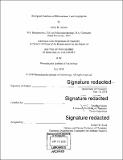Biological Functions of ribonuclease 1 and angiogenin
Author(s)
Garnett, Emily R. (Emily Rose)
DownloadFull printable version (13.63Mb)
Other Contributors
Massachusetts Institute of Technology. Department of Chemistry.
Advisor
Ronald T. Raines.
Terms of use
Metadata
Show full item recordAbstract
Pancreatic-type ribonucleases (ptRNases) are a large family of vertebrate-specific secretory endoribonucleases. They catalyze degradation of many RNA substrates, mediating a variety of biological functions. The homology shared by ptRNases has enabled extensive biochemical characterization and evolutionary study of these enzymes, yet understanding of their biological roles is still incomplete. The goal of this thesis is to identify novel physiological functions for two ptRNases, RNase 1 and angiogenin, through characterization of murine model systems. In Chapter 1, I introduce the ptRNase superfamily and highlight evidence of biological function for RNase 1 and angiogenin that has motivated and informed our study of these enzymes. Extracellular RNA drives blood coagulation, which is preventable by administration of RNase A. In Chapter 2, I demonstrate that loss of RNase 1, a nonspecific and extracellular ptRNase similar to RNase A, results in the potentiation of blood coagulation by activation of coagulation factors in mice. Angiogenin is a ptRNase with unique angiogenic activity and suggested biological function in cancer and amyotrophic lateral sclerosis, as well as in cellular growth and quiescence. My studies demonstrate a fundamental role for angiogenin. In Chapter 3, I find that this enzyme is essential for the development of mice, with heterozygosity for angiogenin resulting in impaired vascularization of the placenta and reduced survival of offspring. Biological study of ptRNases is hampered by the high degree of conservation of the family, which engenders antibody nonspecificity. In Chapter 4, I describe efforts to generate novel specific anti-ptRNase antibodies by producing tagged ptRNases for use in an antibody phage-display workflow. Finally, Chapter 5 outlines future directions for the study of RNase 1 and angiogenin. Taken together, this thesis reveals a more complete picture of the physiological niches of these two enzymes, confirming some previously suspected roles, ascribing new ones, and providing groundwork for future characterization of the biology of these and other ptRNases.
Description
Thesis: Ph. D. in Biological Chemistry, Massachusetts Institute of Technology, Department of Chemistry, 2018. Cataloged from PDF version of thesis. Includes bibliographical references (pages 128-142).
Date issued
2018Department
Massachusetts Institute of Technology. Department of ChemistryPublisher
Massachusetts Institute of Technology
Keywords
Chemistry.